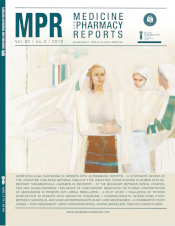Pharmacokinetic interactions study between carvedilol and some antidepressants in rat liver microsoms – a comparative study
DOI:
https://doi.org/10.15386/mpr-1225Keywords:
pharmacokinetics, CYP2D6, rat liver microsomes, carvedilol, antidepressantsAbstract
Background and aims. Cardiovascular diseases and depressive disorders are some of the most frequent diseases. The probability of concomitant prescription of antihypertensive and antidepressive medication is increasing. The aim of this study was to investigate the enzyme inhibition by bupropion, sertraline and fluvoxamine on the metabolism of carvedilol using rat pooled liver microsomes and to assess the importance of these interactions from the pharmacokinetic mechanism point of view.
Methods. Two substrate concentrations (0.5 and 1 μM) and four inhibitor concentrations (0, 0.1, 0.75 and 1.5 μM) were used for each tested inhibitor.
Results. The results of the in vitro experiments showed a significant decrease of the metabolic rate of carvedilol to 4'-hydroxyphenyl carvedilol, for all tested inhibitors, when the inhibitor was added to the incubation mixture containing the substrate. Moreover, an increase of the area under the concentration-time curve for carvedilol was observed after incubation with each tested inhibitor compared with the control state (no inhibitor). The most potent inhibitor was sertraline, followed by fluvoxamine and bupropion.
Conclusion. The co-administration of tested antidepressants led to a significant alteration of carvedilol’s metabolism in vitro. CYP2D6 inhibition is the main pharmacokinetic mechanism that can explain these drug-drug interactions, with possible clinical implications.
Downloads
Published
How to Cite
Issue
Section
License
The authors are required to transfer the copyright of the published paper to the journal. This is done by agreeing to sign the Copyright Assignment Form. Whenever the case, authors are also required to send permissions to reproduce material (such as illustrations) from the copyright holder.

The papers published in the journal are licensed under a Creative Commons Attribution-NonCommercial-NoDerivatives 4.0 International License.

